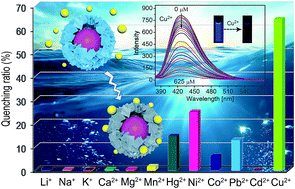Internally extended growth of core–shell NH2-MIL-101(Al)@ZIF-8 nanoflowers for the simultaneous detection and removal of Cu(ii)†
Abstract
The excessive accumulation of toxic copper species makes it imperative to develop smart dual-functional materials for the simultaneous removal and detection of Cu(II) in drinking water. In this work, novel core–shell NH2-MIL-101(Al)@ZIF-8 nanoflowers were successfully fabricated via an internal extended growth mode under the regulation of polyvinylpyrrolidone (PVP) to achieve this goal. Benefiting from the specific affinity of imidazole nitrogen in ZIF-8 toward Cu(II), the resultant NH2-MIL-101(Al)@ZIF-8 shows high adsorption capacity (526.74 mg g−1). Moreover, the fluorescence of NH2-MIL-101(Al) shows a Cu(II)-dependent change, causing this composite to possess superior selective/sensitive detection with a broad linear range (1.5–625 μM) and a low detection limit (0.17 μM) for Cu(II). Specifically, the hybrid MOF@MOF structure provides greater sensitivity as compared to the individual constituent (pristine NH2-MIL-101(Al)) and the mixed state, which is ascribed to the rational optimization of the smart adsorbent based on the following two aspects. (i) The synergistic effect of the core–shell nanostructure improves the preconcentration ability at the interface between single MOFs. (ii) The existence of the three-dimensional hierarchical nanoflower architecture (structure optimization) accelerates the mass transport and sculpts the final composite with enhanced adsorption and detection ability. These indicate that the smart NH2-MIL-101(Al)@ZIF-8 nanoflower could be an excellent candidate for the synchronous remediation and selective detection of Cu(II) in aqueous systems, which could be potentially useful in wastewater treatment and water quality monitoring.



 Please wait while we load your content...
Please wait while we load your content...